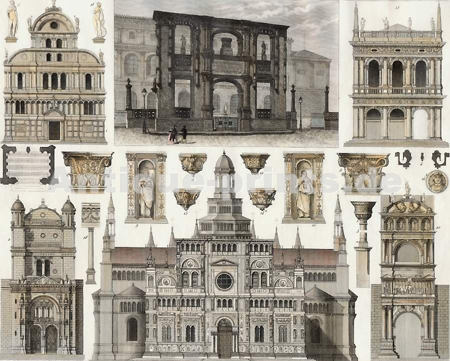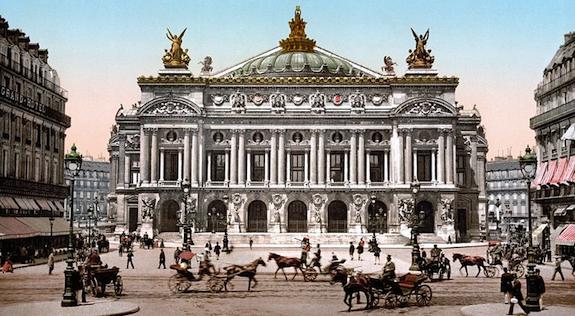Anthony Sutcliffe, Paris: An Architectural History
We have been focusing largely on painting, but Sutcliffe here provides evidence that there was a parallel obsession with continuing the patterns of the past in French architecture, despite the technological transformations which accompanied the Industrial Revolution.
THE ECOLE DES BEAUX-ARTS
If building was depressed between the Revolution and the Second Empire, architectural education was re-established on a strong footing. This  educational system was based on the Ecole des Beaux-Arts in Paris. During the nineteenth century it built up a reputation as the world's finest school of architecture. It would become a Mecca for student architects from abroad, and would extend the influence and example of French architecture throughout the globe. At the same time, the 'Beaux-Arts style', which would be widely acknowledged as the world's most complete and refined approach to building until as late as the First World War, became almost universal in France for public buildings and luxurious private buildings of all sorts. There is no doubt that the Ecole provided a thorough architectural training which would remain unequalled anywhere in the world at least until the end of the century. The architecture of the Ecole nevertheless served the State, the aristocracy and the rich. Large public buildings were prominent among the design projects. In a course as thorough and academic as this, students were introduced to a variety of styles, but in the projects and competitions which measured their progress through the course, the contemporary variants of the French classical style were used almost universally. The highlight of the programme was .the annual Grand Prix de Rome (as it had come to be called by the mid-nineteenth century), the direct descendant of the eighteenth-century contest. This was a competition for designs for an important building, usually public in character, such as an embassy, a palace, a ministry or a luxurious resort hotel. Not only did the winner secure a further period of study of four or five years in Rome, much of it literally among the ruins, but he could aspire to an important public appointment or contract almost immediately on his return. Indeed, he could see his way forward, with considerable confidence, to a comfortable dotage as a doyen of the profession - in addition, with a good chance of being elected as one of the eight members of the architectural academy, which would make him in his turn a judge of Rome prize entries. Competition and continuity thus went together in the Prix de Rome.
educational system was based on the Ecole des Beaux-Arts in Paris. During the nineteenth century it built up a reputation as the world's finest school of architecture. It would become a Mecca for student architects from abroad, and would extend the influence and example of French architecture throughout the globe. At the same time, the 'Beaux-Arts style', which would be widely acknowledged as the world's most complete and refined approach to building until as late as the First World War, became almost universal in France for public buildings and luxurious private buildings of all sorts. There is no doubt that the Ecole provided a thorough architectural training which would remain unequalled anywhere in the world at least until the end of the century. The architecture of the Ecole nevertheless served the State, the aristocracy and the rich. Large public buildings were prominent among the design projects. In a course as thorough and academic as this, students were introduced to a variety of styles, but in the projects and competitions which measured their progress through the course, the contemporary variants of the French classical style were used almost universally. The highlight of the programme was .the annual Grand Prix de Rome (as it had come to be called by the mid-nineteenth century), the direct descendant of the eighteenth-century contest. This was a competition for designs for an important building, usually public in character, such as an embassy, a palace, a ministry or a luxurious resort hotel. Not only did the winner secure a further period of study of four or five years in Rome, much of it literally among the ruins, but he could aspire to an important public appointment or contract almost immediately on his return. Indeed, he could see his way forward, with considerable confidence, to a comfortable dotage as a doyen of the profession - in addition, with a good chance of being elected as one of the eight members of the architectural academy, which would make him in his turn a judge of Rome prize entries. Competition and continuity thus went together in the Prix de Rome.
Charles Garnier's Paris Opera (1875)
|
The most distinctive feature of the Ecole was the unit of practical study, the atelier. These were studios of varying sizes to which students were normally attached. They were directed either by professors of the school or independent architects of distinction. Many were themselves winners of the Rome prize. Some twenty to thirty students worked in each atelier, usually in very cramped conditions. Here, they completed school assignments, prepared competition entries, and sometimes worked on commissions secured by the head of the atelier. Some ateliers were part of the Ecole and occupied space within the building or in houses nearby. Others were almost independent of the Ecole. By bringing together students at all stages of their development, and carrying through a variety of projects, the ateliers provided something approaching a practical experience. For most students the atelier was the main place of learning. Lectures at the Ecole, on the other hand, tended to be theoretical, didactic and often vague. They were, however, well attended, and apparently appreciated by the students.
Although the Ecole des Beaux-Arts provided a full and stimulating training for architects, its concentration on classical architecture and its French derivatives was too strong to ignore or avoid. Most graduates of the Ecole were aware of other styles and were able to design in them well enough, but they did not anticipate much opportunity to do so in their professional lives. Those . able students who aspired to win the Prix de Rome or one of the minor prizes put their main effort into perfecting their mastery of classical design. Although broad concepts were valued by the judges, much emphasis was placed on detail in the later stages of the competition.
ARCHITECTURE, INDUSTRIALISATION AND MODERNISATION
In 1850 Leonce Reynaud published the first volume of his weighty Traite d'architecture, Reynaud was a professor of architecture at the Ecole Polytechnique, the national school for military engineers. Architecture was taught there mainly to ensure that some at least of the corps of engineers could design a respectable school, hospital or customs post in some distant colony. His approach was down-to-earth, stressing construction and components rather than planning and aesthetics. Here, we might surmise, a modern architecture might be found. However, his introduction, which was almost certainly his introductory lecture in his Ecole course, set out an ideal of French classicism which would not have been out of place in a eulogy at the Ecole des Beaux-Arts. With the wheels of the French Industrial Revolution already turning, it is worth quoting at some length: ". .. we have a very appropriate system of architecture, which responds utterly to the demands of our customs, our climate, our materials, and our taste. It is linked of course to Greece and Rome, but only in the same way as our literature and our civilisation are; like them it can draw valuable guidance from the world of the ancients but it does not look for absolute precepts there. It proved its independence and its strength by building the Louvre, that palace sans pareil, the chateau of Fontainebleau, the Tuileries, the chateaux of Anet and Blois, Versailles, the Hotel de Ville of Paris, the hotels of the Place de la Concorde, and so many other admirable monuments in which we should take pride. Men like Pierre Lescot, Jean Bullant, Philibert Delorme, Le Mercier, Mansard, and their successors, all of whom have contributed to the lustre of French architecture, were definitely not humble copyists or sterile plagiarists, as some have dared to suggest. They proved themselves to be just as true, and just as virtuous, as our poets, our painters and our sculptors. Just as much as these, they conformed to the inspirations of our national genius. Art has not abandoned us in our buildings any more than it has in the other areas . . ."
